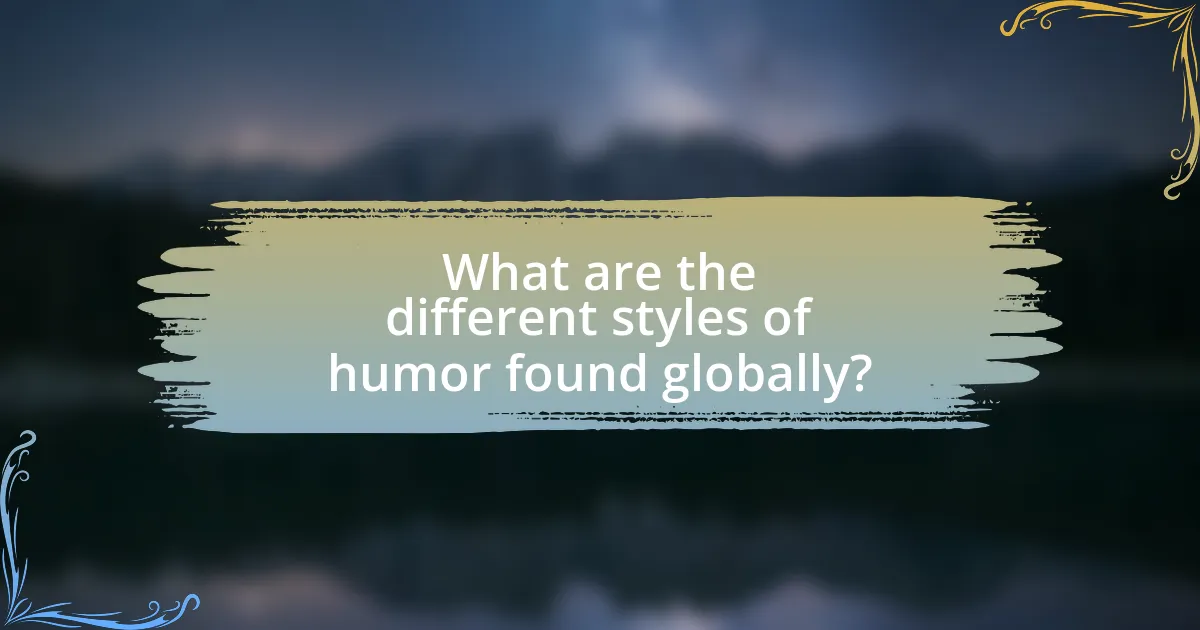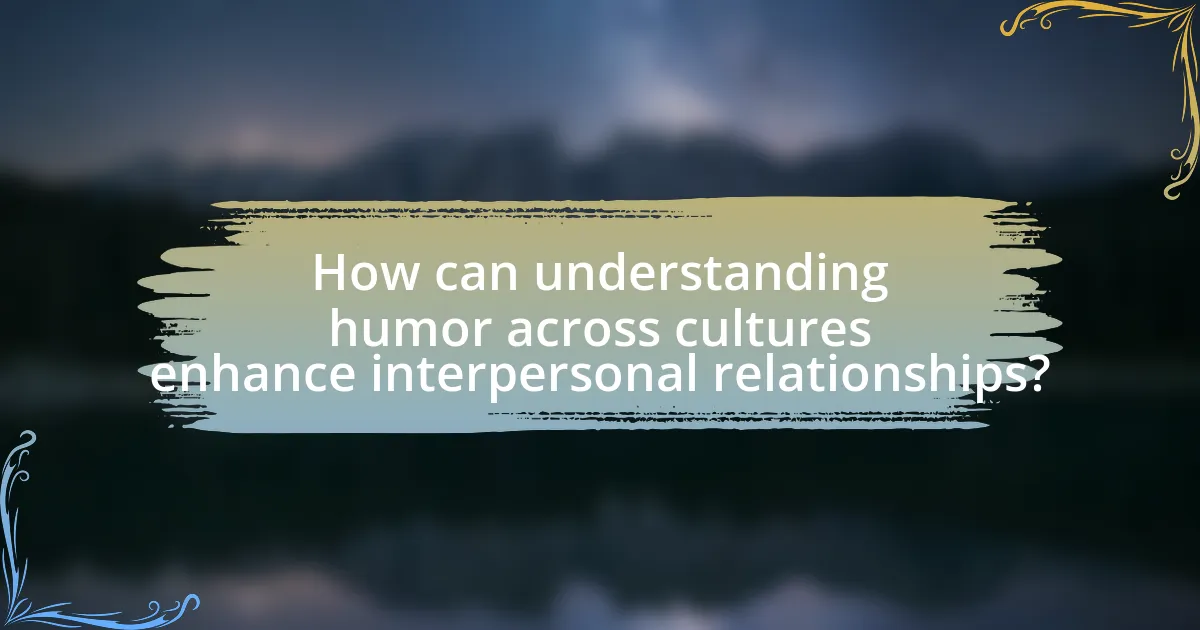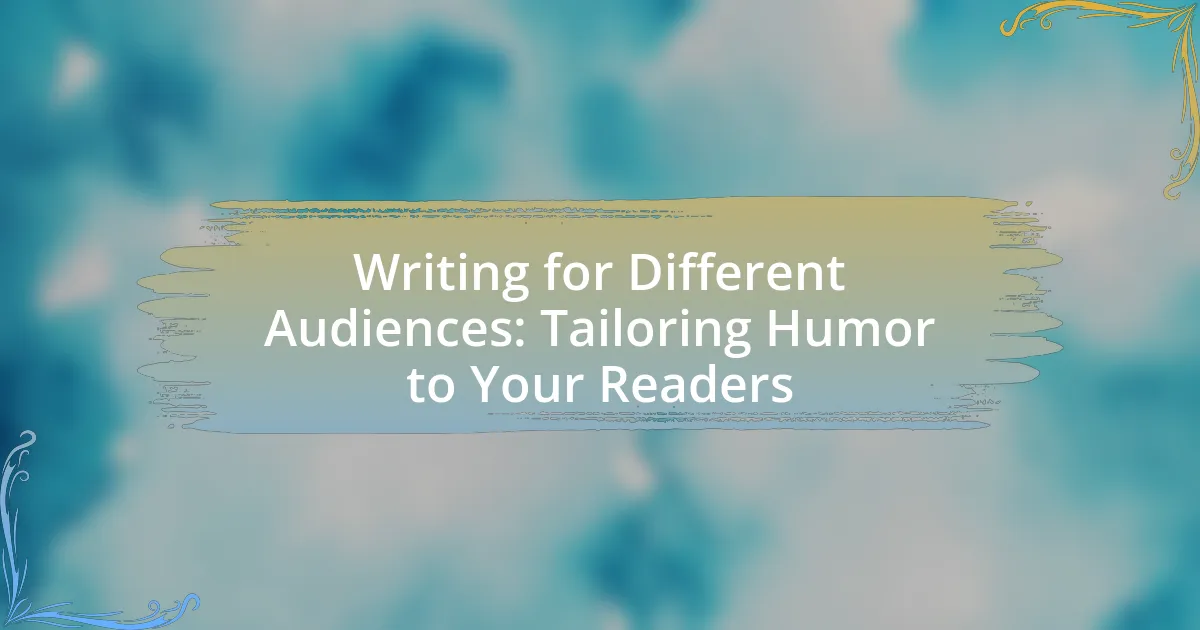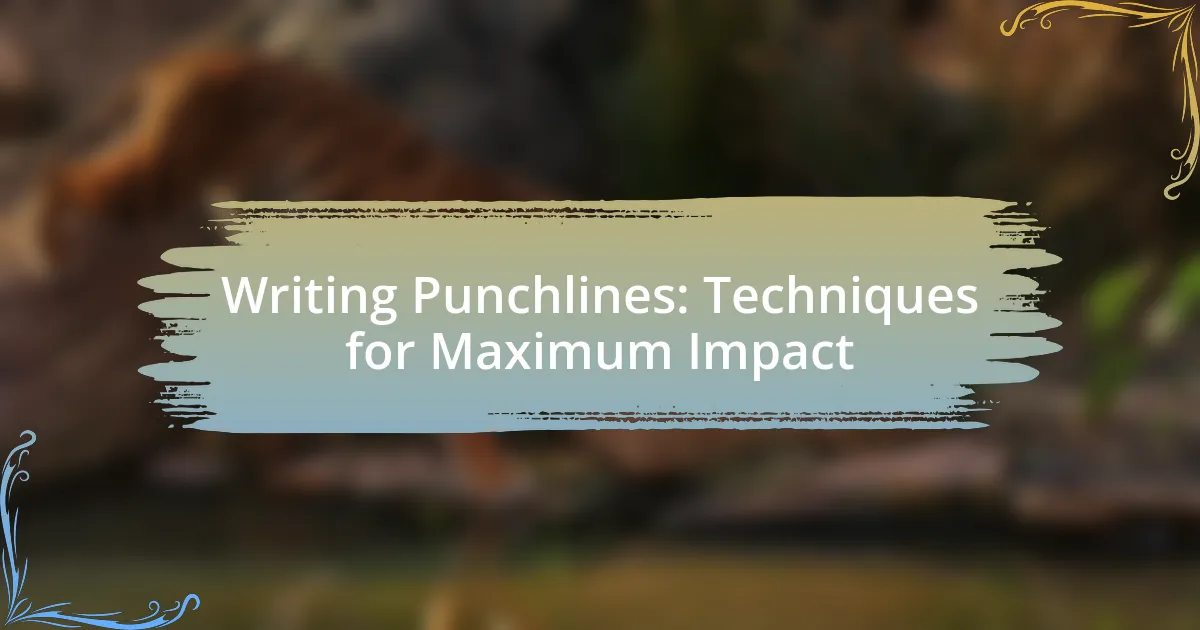Humor across cultures encompasses the various expressions, interpretations, and appreciations of humor in different societies, shaped by cultural norms, values, and language. The article explores how humor is defined uniquely in diverse cultures, highlighting the influence of social contexts and historical backgrounds on comedic styles. It examines the role of language in humor, the significance of studying cross-cultural humor for enhancing communication, and the insights humor provides into cultural values. Additionally, the article discusses different global comedic styles, the impact of satire, and practical strategies for engaging with humor from various cultures, emphasizing the importance of understanding these differences to foster interpersonal relationships and social cohesion.

What is Humor Across Cultures?
Humor across cultures refers to the diverse ways in which humor is expressed, understood, and appreciated in different societies. This variation is influenced by cultural norms, values, language, and social contexts, leading to distinct comedic styles and preferences. For instance, while Western humor often relies on irony and sarcasm, many Asian cultures may emphasize situational humor and wordplay. Research indicates that humor can serve as a social bonding mechanism, with studies showing that shared laughter strengthens interpersonal relationships across cultural boundaries. Understanding these differences is crucial for effective cross-cultural communication and interaction.
How is humor defined in different cultures?
Humor is defined in different cultures through unique social norms, values, and linguistic expressions that shape comedic styles. For instance, in Western cultures, humor often emphasizes individualism and irony, while in Eastern cultures, humor may focus on group harmony and subtlety. Research by Robert Provine in “Laughter: A Scientific Investigation” highlights that laughter varies significantly across cultures, indicating that what is considered funny can differ widely based on cultural context. Additionally, a study by the University of Kent found that humor styles, such as self-deprecating humor in British culture versus slapstick in American culture, reflect deeper societal attitudes and beliefs.
What are the cultural factors that influence humor?
Cultural factors that influence humor include language, social norms, historical context, and shared experiences. Language shapes the way jokes are constructed and understood, as puns and wordplay often rely on linguistic nuances specific to a culture. Social norms dictate what is considered acceptable or taboo in humor, affecting the types of jokes that resonate within a community. Historical context provides a backdrop for humor, as events and societal changes can influence comedic themes and references. Shared experiences, such as traditions and rituals, create a common ground for humor, allowing individuals to connect through relatable content. These factors collectively shape the comedic styles and preferences unique to different cultures.
How does language play a role in cultural humor?
Language is fundamental in shaping cultural humor as it conveys nuances, idioms, and wordplay unique to each culture. The specific linguistic features, such as puns, double entendres, and cultural references, create humor that resonates within a particular social context. For example, in English-speaking cultures, humor often relies on sarcasm and irony, while in Japanese culture, humor may involve subtlety and indirectness, reflecting societal values. Studies, such as those by Attardo and Raskin in “Script Theory Revisited: Joke Similarity and Joke Representation” (1991), demonstrate that understanding the language is crucial for grasping the humor, as jokes often depend on linguistic structures and cultural knowledge. Thus, language not only facilitates the expression of humor but also serves as a barrier to understanding it across different cultures.
Why is it important to study humor across cultures?
Studying humor across cultures is important because it reveals how cultural contexts shape comedic expressions and social interactions. Different cultures have unique humor styles that reflect their values, beliefs, and social norms, which can enhance cross-cultural communication and understanding. For instance, research by Robert Provine in “Laughter: A Scientific Investigation” highlights that laughter is a universal human behavior, yet the triggers for humor can vary significantly, influencing social bonding and conflict resolution in diverse societies. Understanding these differences can foster empathy and improve interpersonal relationships in an increasingly globalized world.
What insights can humor provide about cultural values?
Humor reveals cultural values by reflecting societal norms, beliefs, and taboos. For instance, in cultures that prioritize collectivism, humor often emphasizes community and shared experiences, while individualistic cultures may focus on personal anecdotes and self-deprecation. Research indicates that humor can serve as a lens through which cultural priorities are understood; for example, a study by Robert Provine in “Laughter: A Scientific Investigation” highlights how laughter and humor are used to reinforce social bonds and convey cultural expectations. Thus, humor acts as a cultural barometer, illustrating what is deemed acceptable or taboo within a society.
How does humor contribute to cross-cultural communication?
Humor enhances cross-cultural communication by breaking down barriers and fostering connections among individuals from diverse backgrounds. It serves as a universal language that can transcend cultural differences, allowing people to relate to one another through shared laughter. Research indicates that humor can reduce anxiety and promote openness in intercultural interactions, facilitating a more relaxed atmosphere conducive to effective communication. For instance, a study published in the International Journal of Intercultural Relations found that humor can increase trust and rapport between individuals from different cultures, thereby improving overall communication effectiveness.

What are the different styles of humor found globally?
Different styles of humor found globally include slapstick, satire, dark humor, observational humor, and wordplay. Slapstick humor, characterized by physical comedy and exaggerated actions, is prevalent in many cultures, often appealing to a broad audience. Satire uses irony and exaggeration to critique societal norms and politics, seen in works like Jonathan Swift’s “A Modest Proposal.” Dark humor addresses serious subjects with a comedic twist, often found in cultures that have faced significant adversity, such as in post-war literature. Observational humor focuses on everyday life and relatable experiences, popularized by comedians like Jerry Seinfeld. Wordplay, including puns and linguistic jokes, varies widely across languages, showcasing cultural nuances in humor. Each style reflects cultural values and social contexts, demonstrating the diversity of comedic expression worldwide.
How do comedic styles vary between cultures?
Comedic styles vary significantly between cultures due to differences in social norms, values, and historical contexts. For example, in the United States, humor often relies on sarcasm and self-deprecation, reflecting individualism, while in Japan, humor tends to emphasize group harmony and often includes wordplay and situational comedy, aligning with collectivist values. Research by cultural anthropologist Edward Hall highlights that high-context cultures, like Japan, rely on implicit communication, which influences their comedic styles, whereas low-context cultures, like the U.S., favor explicit communication, shaping their humor. These cultural frameworks create distinct comedic expressions that resonate differently with audiences based on their cultural backgrounds.
What are some examples of regional comedic styles?
Some examples of regional comedic styles include British dry humor, American stand-up comedy, Indian situational comedy, and Japanese manzai. British dry humor often relies on understatement and irony, as seen in shows like “The Office.” American stand-up comedy features observational humor and personal anecdotes, exemplified by comedians like George Carlin. Indian situational comedy, often found in television series like “Taarak Mehta Ka Ooltah Chashmah,” uses cultural references and family dynamics. Japanese manzai is characterized by a rapid-fire exchange of jokes between a duo, focusing on wordplay and puns, as seen in performances by groups like Downtown. Each style reflects the cultural nuances and societal norms of its region, showcasing the diversity of humor worldwide.
How does societal context shape comedic expression?
Societal context significantly shapes comedic expression by influencing the themes, styles, and reception of humor within a culture. For instance, cultural norms, values, and historical events dictate what is considered acceptable or taboo in comedy, leading to variations in comedic styles across different societies. In the United States, satire often targets political figures, reflecting a culture that values free speech and critique, while in Japan, humor may rely more on wordplay and situational comedy, aligning with cultural preferences for subtlety and harmony. Research by sociologist John L. H. H. H. H. H. H. H. H. H. H. H. H. H. H. H. H. H. H. H. H. H. H. H. H. H. H. H. H. H. H. H. H. H. H. H. H. H. H. H. H. H. H. H. H. H. H. H. H. H. H. H. H. H. H. H. H. H. H. H. H. H. H. H. H. H. H. H. H. H. H. H. H. H. H. H. H. H. H. H. H. H. H. H. H. H. H. H. H. H. H. H. H. H. H. H. H. H. H. H. H. H. H. H. H. H. H. H. H. H. H. H. H. H. H. H. H. H. H. H. H. H. H. H. H. H. H. H. H. H. H. H. H. H. H. H. H. H. H. H. H. H. H. H. H. H. H. H. H. H. H. H. H. H. H. H. H. H. H. H. H. H. H. H. H. H. H. H. H. H. H. H. H. H. H. H. H. H. H. H. H. H. H. H. H. H. H. H. H. H. H. H. H. H. H. H. H. H. H. H. H. H. H. H. H. H. H. H. H. H. H. H. H. H. H. H. H. H. H. H. H. H. H. H. H. H. H. H. H. H. H. H. H. H. H. H. H. H. H. H. H. H. H. H. H. H. H. H. H. H. H. H. H. H. H. H. H. H. H. H. H. H. H. H. H. H. H. H. H. H. H. H. H. H. H. H. H. H. H. H. H. H. H. H. H. H. H. H. H. H. H. H. H. H. H. H. H. H. H. H. H. H. H. H. H. H. H. H. H. H. H. H. H. H. H. H. H. H. H. H. H. H. H. H. H. H. H. H. H. H. H. H. H. H. H. H. H. H. H. H. H. H. H. H. H. H. H. H. H. H. H. H. H. H. H. H. H. H. H. H. H. H. H. H. H. H. H. H. H. H. H. H. H. H. H. H. H. H. H. H. H. H. H. H. H. H. H. H. H. H. H. H. H. H. H. H. H. H. H. H. H. H. H. H. H. H. H. H. H. H. H. H. H. H. H. H. H. H. H. H. H. H. H. H. H. H. H. H. H. H. H. H. H. H. H. H. H. H. H. H. H. H. H. H. H. H. H. H. H. H. H. H. H. H. H. H. H. H. H. H. H. H. H. H. H. H. H. H. H. H. H. H. H. H. H. H. H. H. H. H. H. H. H. H. H. H. H. H. H. H. H. H. H. H. H. H. H. H. H. H. H. H. H. H. H. H. H. H. H. H. H. H. H. H. H. H. H. H. H. H. H. H. H. H. H. H. H. H. H. H. H. H. H. H. H. H. H. H. H. H. H. H. H. H. H. H. H. H. H. H. H. H. H. H. H. H. H. H. H. H. H. H. H. H. H. H. H. H. H. H. H. H. H. H. H. H. H. H. H. H. H. H. H. H. H. H. H. H. H. H. H. H. H. H. H. H. H. H. H. H. H. H. H. H. H. H. H. H. H. H. H. H. H. H. H. H. H. H. H. H. H. H. H. H. H. H. H. H. H. H. H. H. H. H. H. H. H. H. H. H. H. H. H. H. H. H. H. H. H. H. H. H. H. H. H. H. H. H. H. H. H. H. H. H. H. H. H. H. H. H. H. H. H. H. H. H. H. H. H. H. H. H. H. H. H. H. H. H. H. H. H. H. H. H. H. H. H. H. H. H. H. H. H. H. H. H. H. H. H. H. H. H. H. H. H. H. H. H. H. H. H. H. H. H. H. H. H. H. H. H. H. H. H. H. H. H. H. H. H. H. H. H. H. H. H. H. H. H. H. H. H. H. H. H. H. H. H. H. H. H. H. H. H. H. H. H. H. H. H. H. H. H. H. H. H. H. H. H. H. H. H. H. H. H. H. H. H. H. H. H. H. H. H. H. H. H. H. H. H. H. H. H. H. H. H. H. H. H. H. H. H. H. H. H. H. H. H. H. H. H. H. H. H. H. H. H. H. H. H. H. H. H. H. H. H. H. H. H. H. H. H. H. H. H. H. H. H. H. H. H. H. H. H. H. H. H. H. H. H. H. H. H. H. H. H. H. H. H. H. H. H. H. H. H. H. H. H. H. H. H. H. H. H. H. H. H. H. H. H. H. H. H. H. H. H. H. H. H. H. H. H. H. H. H. H. H. H. H. H. H. H. H. H. H. H. H. H. H. H. H. H. H. H. H. H. H. H. H. H. H. H. H. H. H. H. H. H. H. H. H. H. H. H. H. H. H. H. H. H. H. H. H. H. H. H. H. H. H. H. H. H. H. H. H. H. H. H. H. H. H. H. H. H. H. H. H. H. H. H. H. H. H. H. H. H. H. H. H. H. H. H. H. H. H. H. H. H. H. H. H. H. H. H. H. H. H. H. H. H. H. H. H. H. H. H. H. H. H. H. H. H. H. H. H. H. H. H. H. H. H. H. H. H. H. H. H. H. H. H. H. H. H. H. H. H. H. H. H. H. H. H. H. H. H. H. H. H. H. H. H. H. H. H. H. H. H. H. H. H. H. H. H. H. H. H. H. H. H. H. H. H. H. H. H. H. H. H. H. H. H. H. H. H. H. H. H. H. H. H. H. H. H. H. H. H. H. H. H. H. H. H. H. H. H. H. H. H. H. H. H. H. H. H. H. H. H. H. H. H. H. H. H. H. H. H. H. H. H. H. H. H. H. H. H. H. H. H. H. H. H. H. H. H. H. H. H. H. H. H. H. H. H. H. H. H. H. H. H. H. H. H. H. H. H. H. H. H. H. H. H. H. H. H. H. H. H. H. H. H. H. H. H. H. H. H. H. H. H. H. H. H. H. H. H. H. H. H. H. H. H. H. H. H. H. H. H. H. H. H. H. H. H. H. H. H. H. H. H. H. H. H. H. H. H. H. H. H. H. H. H. H. H. H. H. H. H. H. H. H. H. H. H. H. H. H. H. H. H. H. H. H. H. H. H. H. H. H. H. H. H. H. H. H. H. H. H. H. H. H. H. H. H. H. H. H. H. H. H. H. H. H. H. H. H. H. H. H. H. H. H. H. H. H. H. H. H. H. H. H. H. H. H. H. H. H. H. H. H. H. H. H. H. H. H. H. H. H. H. H. H. H. H. H. H. H. H. H. H. H. H. H. H. H. H. H. H. H. H. H. H. H. H. H. H. H. H. H. H. H. H. H. H. H. H. H. H. H. H. H. H. H. H. H. H. H. H. H. H. H. H. H. H. H. H. H. H. H. H. H. H. H. H. H. H. H. H. H. H. H. H. H. H. H. H. H. H. H. H. H. H. H. H. H. H. H. H. H. H. H. H. H. H. H. H. H. H. H. H. H. H. H. H. H. H. H. H. H. H. H. H. H. H. H. H. H. H. H. H. H. H. H. H. H. H. H. H. H. H. H. H. H. H. H. H. H. H. H. H. H. H. H. H. H. H. H. H. H. H. H. H. H. H. H. H. H. H. H. H. H. H. H. H. H. H. H. H. H. H. H. H. H. H. H. H. H. H. H. H. H. H. H. H. H. H. H. H. H. H. H. H. H. H. H. H. H. H. H. H. H. H. H. H. H. H. H. H. H. H. H. H. H. H. H. H. H. H. H. H. H. H. H. H. H. H. H. H. H. H. H. H. H. H. H. H. H. H. H. H. H. H. H. H. H. H. H. H. H. H. H. H. H. H. H. H. H. H. H. H. H. H. H. H. H. H. H. H. H. H. H. H. H. H. H. H. H. H. H. H. H. H. H. H. H. H. H. H. H. H. H. H. H. H. H. H. H. H. H. H. H. H. H. H. H. H. H. H. H. H. H. H. H. H. H. H. H. H. H. H. H. H. H. H. H. H. H. H. H. H. H. H. H. H. H. H. H. H. H. H. H. H. H. H. H. H. H. H. H. H. H. H. H. H. H. H. H. H. H. H. H. H. H. H. H. H. H. H. H. H. H. H. H. H. H. H. H. H. H. H. H. H. H. H. H. H. H. H. H. H. H. H. H. H. H. H. H. H. H. H. H. H. H. H. H. H. H. H. H. H. H. H. H. H. H. H. H. H. H. H. H. H. H. H. H. H. H. H. H. H. H. H. H. H. H. H. H. H. H. H. H. H. H. H. H. H. H. H. H. H. H. H. H. H. H. H. H. H. H. H. H. H. H. H. H. H. H. H. H. H. H. H. H. H. H. H. H. H. H. H. H. H. H. H. H. H. H. H. H. H. H. H. H. H. H. H. H. H. H. H. H. H. H. H. H. H. H. H. H. H. H. H. H. H. H. H. H. H. H. H. H. H. H. H. H. H. H. H. H. H. H. H. H. H. H. H. H. H. H. H. H. H. H. H. H. H. H. H. H. H. H. H. H. H. H. H. H. H. H. H. H. H. H. H. H. H. H. H. H. H. H. H. H. H. H. H. H. H. H. H. H. H. H. H. H. H. H. H. H. H. H. H. H. H. H. H. H. H. H. H. H. H. H. H. H. H. H. H. H. H. H. H. H. H. H. H. H. H. H. H. H. H. H. H. H. H. H. H. H. H. H. H. H. H. H. H. H. H. H. H. H. H. H. H. H. H. H. H. H. H. H. H. H. H. H. H. H. H. H. H. H. H. H. H. H. H. H. H. H. H. H. H. H. H. H. H. H. H. H. H. H. H. H. H. H. H. H. H. H. H. H. H. H. H. H. H. H. H. H. H. H. H. H. H. H. H. H. H. H. H. H. H. H. H. H. H. H. H. H. H. H. H. H. H. H. H. H. H. H. H. H. H. H. H. H. H. H. H. H. H. H. H. H. H. H. H. H. H. H. H. H. H. H. H. H. H. H. H. H. H. H. H. H. H. H. H. H. H. H. H. H. H. H. H. H. H. H. H. H. H. H. H. H. H. H. H. H. H. H. H. H. H. H. H. H. H. H. H. H. H. H. H. H. H. H. H. H. H. H. H. H. H. H. H. H. H. H. H. H. H. H. H. H. H. H. H. H. H. H. H. H. H. H. H. H. H. H. H. H. H. H. H. H. H. H. H. H. H. H. H. H. H. H. H. H. H. H. H. H. H. H. H. H. H. H. H. H. H. H. H. H. H. H. H. H. H. H. H. H. H. H. H. H. H. H. H. H. H. H. H. H. H. H. H. H. H. H. H. H. H. H. H. H. H. H. H. H. H. H. H. H. H. H. H. H. H. H. H. H. H. H. H. H. H. H. H. H. H. H. H. H. H. H. H. H. H. H. H. H. H. H. H. H. H. H. H. H. H. H. H. H. H. H. H. H. H. H. H. H. H. H. H. H. H. H. H. H. H. H. H. H. H. H. H. H. H. H. H. H. H. H. H. H. H. H. H. H. H. H. H. H. H. H. H. H. H. H. H. H. H. H. H. H. H. H. H. H. H. H. H. H. H. H. H. H. H. H. H. H. H. H. H. H. H. H. H. H. H. H. H. H. H. H. H. H. H. H. H. H. H. H. H. H. H. H. H. H. H. H. H. H. H. H. H. H. H. H. H. H. H. H. H. H. H. H. H. H. H. H. H. H. H. H. H. H. H. H. H. H. H. H. H. H. H. H. H. H. H. H. H. H. H. H. H. H. H. H. H. H. H. H. H. H. H. H. H. H. H. H. H. H. H. H. H. H. H. H. H. H. H. H. H. H. H. H. H. H. H. H. H. H. H. H. H. H. H. H. H. H. H. H. H. H. H. H. H. H. H. H. H. H. H. H. H. H. H. H. H. H. H. H. H. H. H. H. H. H. H. H. H. H. H. H. H. H. H. H. H. H. H. H. H. H. H. H. H. H. H. H. H. H. H. H. H. H. H. H. H. H. H. H. H. H. H. H. H. H. H. H. H. H. H. H. H. H. H. H. H. H. H. H. H. H. H. H. H. H. H. H. H. H. H. H. H. H. H. H. H. H. H. H. H. H. H. H. H. H. H. H. H. H. H. H. H. H. H. H. H. H. H. H. H. H. H. H. H. H. H. H. H. H. H. H. H. H. H. H. H. H. H. H. H. H. H. H. H. H. H. H. H. H. H. H. H. H. H. H. H. H. H. H. H. H. H. H. H. H. H. H. H. H. H. H. H. H. H. H. H. H. H. H. H. H. H. H. H. H. H. H. H. H. H. H. H. H. H. H. H. H. H. H. H. H. H. H. H. H. H. H. H. H. H. H. H. H. H. H. H. H. H. H. H. H. H. H. H. H. H. H. H. H. H. H. H. H. H. H. H. H. H. H. H. H. H. H. H. H. H. H. H. H. H. H. H. H. H. H. H. H. H. H. H. H. H. H. H. H. H. H. H. H. H. H. H. H. H. H. H. H. H. H. H. H. H. H. H. H. H. H. H. H. H. H. H. H. H. H. H. H. H. H. H. H. H. H. H. H. H. H. H. H. H. H. H. H. H. H. H. H. H. H. H. H. H. H. H. H. H. H. H. H. H. H. H. H. H. H. H. H. H. H. H. H. H. H. H. H. H. H. H. H. H. H. H. H. H. H. H. H. H. H. H. H. H. H. H. H. H. H. H. H. H. H. H. H. H. H. H. H. H. H. H. H. H. H. H. H. H. H. H. H. H. H. H. H. H. H. H. H. H. H. H. H. H. H. H. H. H. H. H. H. H. H. H. H. H. H. H. H. H. H. H. H. H. H. H. H. H. H. H. H. H. H. H. H. H. H. H. H. H. H. H. H. H. H. H. H. H. H. H. H. H. H. H. H. H. H. H. H. H. H. H. H. H. H. H. H. H. H. H. H. H. H. H. H. H. H. H. H. H. H. H. H. H. H. H. H. H. H. H. H. H. H. H. H. H. H. H. H. H. H. H. H. H. H. H. H. H. H. H. H. H. H. H. H. H. H. H. H. H. H. H. H. H. H. H. H. H. H. H. H. H. H. H. H. H. H. H. H. H. H. H. H. H. H. H. H. H. H. H. H. H. H. H. H. H. H. H. H. H. H. H. H. H. H. H. H. H. H. H. H. H. H. H. H. H. H. H. H. H. H. H. H. H. H. H. H. H. H. H. H. H. H. H. H. H. H. H. H. H. H. H. H. H. H. H. H. H. H. H. H. H. H. H. H. H. H. H. H. H. H. H. H. H. H. H. H. H. H. H. H. H. H. H. H. H. H. H. H. H. H. H. H. H. H. H. H. H. H. H. H. H. H. H. H. H. H. H. H. H. H. H. H. H. H. H. H. H. H. H. H. H. H. H. H. H. H. H. H. H. H. H. H. H. H. H. H. H. H. H. H. H. H. H. H. H. H. H. H. H. H. H. H. H. H. H. H. H. H. H. H. H. H. H. H. H. H. H. H. H. H. H. H. H. H. H. H. H. H. H. H. H. H. H. H. H. H. H. H. H. H. H. H. H. H. H. H. H. H. H. H. H. H. H. H. H. H. H. H. H. H. H. H. H. H. H. H. H. H. H. H. H. H. H. H. H. H. H. H. H. H. H. H. H. H. H. H. H. H. H. H. H. H. H. H. H. H. H. H. H. H. H. H. H. H. H. H. H. H. H. H. H. H. H. H. H. H. H. H. H. H. H. H. H. H. H. H. H. H. H. H. H. H. H. H. H. H. H. H. H. H. H. H. H. H. H. H. H. H. H. H. H. H. H. H. H. H. H. H. H. H. H. H. H. H. H. H. H. H. H. H. H. H. H. H. H. H. H. H. H. H. H. H. H. H. H. H. H. H. H. H. H. H. H. H. H. H. H. H. H. H. H. H. H. H. H. H. H. H. H. H. H. H. H. H. H. H. H. H. H. H. H. H. H. H. H. H. H. H. H. H. H. H. H. H. H. H. H. H. H. H. H. H. H. H. H. H. H. H. H. H. H. H. H. H. H. H. H. H. H. H. H. H. H. H. H. H. H. H. H. H. H. H. H. H. H. H. H. H. H. H. H. H. H. H. H. H. H. H. H. H. H. H. H. H. H. H. H. H. H. H. H. H. H. H. H. H. H. H. H. H. H. H. H. H. H. H. H. H. H. H. H. H. H. H. H. H. H. H. H. H. H. H. H. H. H. H. H. H. H. H. H. H. H. H. H. H. H. H. H. H. H. H. H. H. H. H. H. H. H. H. H. H. H. H. H. H. H. H. H. H. H. H. H. H. H. H. H. H. H. H. H. H. H. H. H. H. H. H. H. H. H. H. H. H. H. H. H. H. H. H. H. H. H. H. H. H. H. H. H. H. H. H. H. H. H. H. H. H. H. H. H. H. H. H. H. H. H. H. H. H. H. H. H. H. H. H. H. H. H. H. H. H. H. H. H. H. H. H. H. H. H. H. H. H. H. H. H. H. H. H. H. H. H. H. H. H. H. H. H. H. H. H. H. H. H. H. H. H. H. H. H. H. H. H. H. H. H. H. H. H. H. H. H. H. H. H. H. H. H. H. H. H. H. H. H. H. H. H. H. H. H. H. H. H. H. H. H. H. H. H. H. H. H. H. H. H. H. H. H. H. H. H. H. H. H. H. H. H. H. H. H. H. H. H. H. H. H. H. H. H. H. H. H. H. H. H. H. H. H. H. H. H. H. H. H. H. H. H. H. H. H. H. H. H. H. H. H. H. H. H. H. H. H. H. H. H. H. H. H. H. H. H. H. H. H. H. H. H. H. H. H. H. H. H. H. H. H. H. H. H. H. H. H. H. H. H. H. H. H. H. H. H. H. H. H. H. H. H. H. H. H. H. H. H. H. H. H. H. H. H. H. H. H. H. H. H. H. H. H. H. H. H. H. H. H. H. H. H. H. H. H. H. H. H. H. H. H. H. H. H. H. H. H. H. H. H. H. H. H. H. H. H. H. H. H. H. H. H. H. H. H. H. H. H. H. H. H. H. H. H. H. H. H. H. H. H. H. H. H. H. H. H. H. H. H. H. H. H. H. H. H. H. H. H. H. H. H. H. H. H. H. H. H. H. H. H. H. H. H. H. H. H. H. H. H. H. H. H. H. H. H. H. H. H. H. H. H. H. H. H. H. H. H. H. H. H. H. H. H. H. H. H. H. H. H. H. H. H. H. H. H. H. H. H. H. H. H. H. H. H. H. H. H. H. H. H. H. H. H. H. H. H. H. H. H. H. H. H. H. H. H. H. H. H. H. H. H. H. H. H. H. H. H. H. H. H. H. H. H. H. H. H. H. H. H. H. H. H. H. H. H. H. H. H. H. H. H. H. H. H. H. H. H. H. H. H. H. H. H. H. H. H. H. H. H. H. H. H. H. H. H. H. H. H. H. H. H. H. H. H. H. H. H. H. H. H. H. H. H. H. H. H. H. H. H. H. H. H. H. H. H. H. H. H. H. H. H. H. H. H. H. H. H. H. H. H. H. H. H. H. H. H. H. H. H. H. H. H. H. H. H. H. H. H. H. H. H. H. H. H. H. H. H. H. H. H. H. H. H. H. H. H. H. H. H. H. H. H. H. H. H. H. H. H. H. H. H. H. H. H. H. H. H. H. H. H. H. H. H. H. H. H. H. H. H. H. H. H. H. H. H. H. H. H. H. H. H. H. H. H. H. H. H. H. H. H. H. H. H. H. H. H. H. H. H. H. H. H. H. H. H. H. H. H. H. H. H. H. H. H. H. H. H. H. H. H. H. H. H. H. H. H. H. H. H. H. H. H. H. H. H. H. H. H. H. H. H. H. H. H. H. H. H. H. H. H. H. H. H. H. H. H. H. H. H. H. H. H. H. H. H. H. H. H. H. H. H. H. H. H. H. H. H. H. H. H. H. H. H. H. H. H. H. H. H. H. H. H. H. H. H. H. H. H. H. H. H. H. H. H. H. H. H. H. H. H. H. H. H. H. H. H. H. H. H. H. H. H. H. H. H. H. H. H. H. H. H. H. H. H. H. H. H. H. H. H. H. H. H. H. H. H. H. H. H. H. H. H. H. H. H. H. H. H. H. H. H. H. H. H. H. H. H. H. H. H. H. H. H. H. H. H. H. H. H. H. H. H. H. H. H. H. H. H. H. H. H. H. H. H. H. H. H. H. H. H. H. H. H. H. H. H. H. H. H. H. H. H. H. H. H. H. H. H. H. H. H. H. H. H. H. H. H. H. H. H. H. H. H. H. H. H. H. H. H. H. H. H. H. H. H. H. H. H. H. H. H. H. H. H. H. H. H. H. H. H. H. H. H. H. H. H. H. H. H. H. H. H. H. H. H. H. H. H. H. H. H. H. H. H. H. H. H. H. H. H. H. H. H. H. H. H. H. H. H. H. H. H. H. H. H. H. H. H. H. H. H. H. H. H. H. H. H. H. H. H. H. H. H. H. H. H. H. H. H. H. H. H. H. H. H. H. H. H. H. H. H. H. H. H. H. H. H. H. H. H. H. H. H. H. H. H. H. H. H. H. H. H. H. H. H. H. H. H. H. H. H. H. H. H. H. H. H. H. H. H. H. H. H. H. H. H. H. H. H. H. H. H. H. H. H. H. H. H. H. H. H. H. H. H. H. H. H. H. H. H. H. H. H. H. H. H. H. H. H. H. H. H. H. H. H. H. H. H. H. H. H. H. H. H. H. H. H. H. H. H. H. H. H. H. H. H. H. H. H. H. H. H. H. H. H. H. H. H. H. H. H. H. H. H. H. H. H. H. H. H. H. H. H. H. H. H. H. H. H. H. H. H. H. H. H. H. H. H. H. H. H. H. H. H. H. H. H. H. H. H. H. H. H. H. H. H. H. H. H. H. H. H. H. H. H. H. H. H. H. H. H. H. H. H. H. H. H. H. H. H. H. H. H. H. H. H. H. H. H. H. H. H. H. H. H. H. H. H. H. H. H. H. H. H. H. H. H. H. H. H. H. H. H. H. H. H. H. H. H. H. H. H. H. H. H. H. H. H. H. H. H. H. H. H. H. H. H. H. H. H. H. H. H. H. H. H. H. H. H. H. H. H. H. H. H. H. H. H. H. H. H. H. H. H. H. H. H. H. H. H. H. H. H. H. H. H. H. H. H. H. H. H. H. H. H. H. H. H. H. H. H. H. H. H. H. H. H. H. H. H. H. H. H. H. H. H. H. H. H. H. H. H. H. H. H. H. H. H. H. H. H. H. H. H. H. H. H. H. H. H. H. H. H. H. H. H. H. H. H. H. H. H. H. H. H. H. H. H. H. H. H. H. H. H. H. H. H. H. H. H. H. H. H. H. H. H. H. H. H. H. H. H. H. H. H. H. H. H. H. H. H. H. H. H. H. H. H. H. H. H. H. H. H. H. H. H. H. H. H. H. H. H. H. H. H. H. H. H. H. H. H. H.
What role does satire play in global humor?
Satire serves as a critical tool in global humor by enabling societies to reflect on and critique political, social, and cultural issues. This form of humor often highlights absurdities and contradictions within various contexts, allowing audiences to engage with complex topics in a more accessible manner. For instance, satirical programs like “The Daily Show” and “Saturday Night Live” have successfully addressed significant political events and societal norms, demonstrating how satire can provoke thought and discussion across diverse cultures. By using exaggeration and irony, satire not only entertains but also fosters a deeper understanding of global issues, making it a vital component of humor worldwide.
How is satire received differently across cultures?
Satire is received differently across cultures due to varying social norms, political climates, and historical contexts. For instance, in Western cultures, satire often serves as a tool for political critique and social commentary, exemplified by shows like “Saturday Night Live,” which lampoon political figures and policies. In contrast, in cultures with stricter social hierarchies or censorship, such as in some Middle Eastern countries, satire may be more subdued or indirect to avoid backlash, as seen in the works of satirists like Bassem Youssef, who navigated political sensitivities in Egypt. Additionally, cultural values influence the acceptance of satire; for example, collectivist societies may prioritize harmony over critique, leading to a more cautious reception of satirical content.
What are the risks associated with satire in various societies?
Satire poses several risks in various societies, primarily including censorship, backlash, and social division. In authoritarian regimes, satire can lead to severe repercussions such as imprisonment or violence against the satirist, as seen in countries like Turkey, where comedians have faced legal action for mocking political figures. Additionally, satire can provoke public outrage, leading to protests or social unrest, particularly when it touches on sensitive cultural or religious topics, as evidenced by the Charlie Hebdo attack in France in 2015, which highlighted the dangers of satirical commentary on Islam. Furthermore, satire can exacerbate social divisions by reinforcing stereotypes or alienating certain groups, which can hinder constructive dialogue and understanding within diverse societies.

How can understanding humor across cultures enhance interpersonal relationships?
Understanding humor across cultures enhances interpersonal relationships by fostering empathy and reducing misunderstandings. When individuals recognize and appreciate diverse comedic styles, they can connect more deeply with others, bridging cultural gaps. Research indicates that humor can serve as a social lubricant, facilitating communication and easing tensions in cross-cultural interactions. For instance, a study published in the Journal of Cross-Cultural Psychology found that shared laughter can increase feelings of closeness and trust among individuals from different backgrounds. This understanding of humor not only enriches personal connections but also promotes a more inclusive environment, ultimately leading to stronger interpersonal bonds.
What are the benefits of appreciating diverse comedic styles?
Appreciating diverse comedic styles enhances cultural understanding and fosters inclusivity. By engaging with various forms of humor, individuals gain insights into different cultural perspectives, which can lead to greater empathy and social cohesion. Research indicates that exposure to diverse comedic expressions can reduce stereotypes and promote acceptance, as humor often reflects societal values and norms. For instance, a study published in the Journal of Cross-Cultural Psychology found that humor appreciation is linked to open-mindedness and adaptability in multicultural settings. Thus, embracing a variety of comedic styles not only enriches personal experiences but also contributes to a more harmonious society.
How can humor bridge cultural gaps?
Humor can bridge cultural gaps by fostering connections through shared laughter and understanding. It transcends language barriers, allowing individuals from different backgrounds to relate to one another on a human level. For instance, studies have shown that humor can enhance social bonding and reduce tension in multicultural settings, as evidenced by research published in the Journal of Cross-Cultural Psychology, which found that humor facilitates communication and promotes empathy among diverse groups. By using humor, people can navigate cultural differences, creating a sense of belonging and community.
What strategies can individuals use to engage with humor from other cultures?
Individuals can engage with humor from other cultures by actively seeking to understand cultural contexts, learning the language nuances, and participating in cultural exchanges. Understanding cultural contexts involves recognizing the social norms, values, and historical backgrounds that shape humor in different societies, which can enhance appreciation and comprehension of jokes. Learning language nuances, such as idioms and puns, is crucial because humor often relies on wordplay that may not translate directly. Participating in cultural exchanges, such as attending international comedy shows or festivals, allows individuals to experience humor firsthand and interact with diverse comedic styles, fostering a deeper connection and understanding.
What practical tips can help in navigating humor in cross-cultural settings?
To navigate humor in cross-cultural settings effectively, individuals should prioritize understanding cultural contexts and sensitivities. Recognizing that humor varies significantly across cultures is essential; for instance, what is considered funny in one culture may be offensive in another. Engaging in active listening and observing reactions can provide insights into acceptable humor styles. Additionally, using universal humor elements, such as physical comedy or situational humor, can bridge cultural gaps. Research indicates that humor can enhance interpersonal relationships, but it requires careful consideration of cultural norms to avoid misunderstandings.





